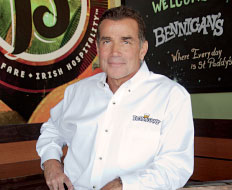Every successful brand relies not only on its leader to craft and execute a winning brand strategy, but also on its executive team members to keep the concept running smoothly. A savvy CEO understands that his or her fellow C-suite members must consistently be inspired to be the highest-quality, top-notch executives possible.
For Phillip Chang, CEO of frozen-yogurt chain Yogurtland, treating employees with dignity and respect is of the utmost importance when it comes to motivating his team. He also prioritizes setting a good example for his fellow executives to follow.
“I emphasize integrity [and] honesty, and work to build a trust with each of them,” he says. “I want them to see what sort of person I am, how I treat my wife, how I act around others. They learn my true character and personality, and know I am more than just the man in charge.”
To show his employees that he values each of their opinions, Chang distributes a 360-degree questionnaire every year in which his executive team members evaluate both him and his work anonymously. He then goes through and addresses each of the comments in front of everyone.
“I read them, and sometimes I have to apologize for things and sometimes it’s very hard, but I am a humble and honest person and this shows them that I am listening,” Chang says. “As the leader, I have to be an example. I think doing this helps people respect me, and the respect trickles down the workplace environment.”
Pierre Panos, founder and CEO of Atlanta-based Fresh To Order, says executive cultivation starts with ensuring that the people who move into leadership positions understand the culture of the company, live and breathe it daily, and teach it to the next level of leaders.
“If you strategically choose your leaders and acculturate them, they are already motivated individuals,” he says. “However, to foster their growth, I have always believed in painting a very realistic but aspirational picture of where I want the brand to go, providing the correct incentives and a clear line of sight. This ensures our leaders get the payoff if we meet our goals.”
Stretching the abilities and roles of top executives by enabling them to take on more responsibilities and projects as they mature in their position with the brand also helps ensure that executive team members consistently remain motivated, engaged, and inspired.
At Fresh To Order, Panos says, executives are very responsive to this approach. Because they have been specifically selected for positions based on their abilities, it gives them energy when they perform those functions.
“I have a very clear sense of what my unique ability is, and I am careful to surround myself with seasoned executives who have come up through the company and who supplement their unique abilities with mine,” Panos says. “Together we have something truly distinctive that multiplies our results exponentially.”
By respecting the boundaries of each executive team member’s role and responsibilities, C-suite executives are able to have full control over their position, Panos says, which can be empowering.
For executive team members to flourish, strong leaders must set the direction and vision of the company but then let their colleagues take the ball and run with it, says Paul Murphy, CEO of Mexican quick-serve chain Del Taco.
“You can’t micromanage too much,” he says. “They have the background and experience, and you want them to have the space to do their jobs and grow.”
Murphy also allows his leadership team to attend functions and forums to seek other perspectives and mingle with leaders of other companies. “They can get together and discuss best practices and bounce ideas off of [each other],” he says. “Just by interacting, you learn to get inspired.”
Still, the most critical thing that Murphy does as a brand leader to show he cares for his executives is emphasize a strong balance between work and family. That means recognizing not only the victories of his team members at work, but also those events that happen in his team’s lives outside of the office, he says.
“I have known many leaders who don’t reach out to their workers, but to me, I believe in following the golden rule and showing that you care,” Murphy says. “Invest the time. That means handwritten notes, asking about families. … It not only motivates the executive, but also gets their family behind what they are doing at work.”
Paul Mangiamele, CEO of Texas-based Bennigan’s, says team-building exercises are a great way to get all executive members excited and on the same page.
“To inspire your team, you need open ears, open eyes, and an open heart,” he says. “You need to show your passion and bring out the passion in your team. Attitude is everything, and we all have to work as a team to keep our brand growing.”
Keeping the brand on message is a strategy that Sam Borgese, CEO of Max Brenner International, also feels is important for executive team-member cultivation. He says it’s essential for CEOs to step out of the leadership role to show they understand that every part of the business is important.
“The employees like to see all of us rolling up our sleeves and seeing how the business works,” Borgese says.
“We have a young team that tends to be outspoken and you can’t improve without having those people be vocal,” he adds. “I encourage a lot of input and try to align everyone as a team.”













